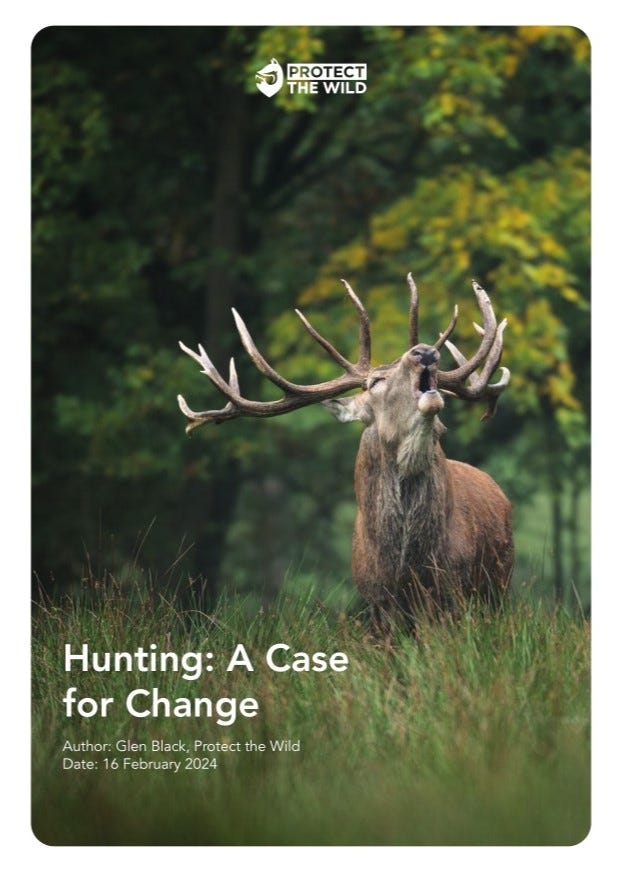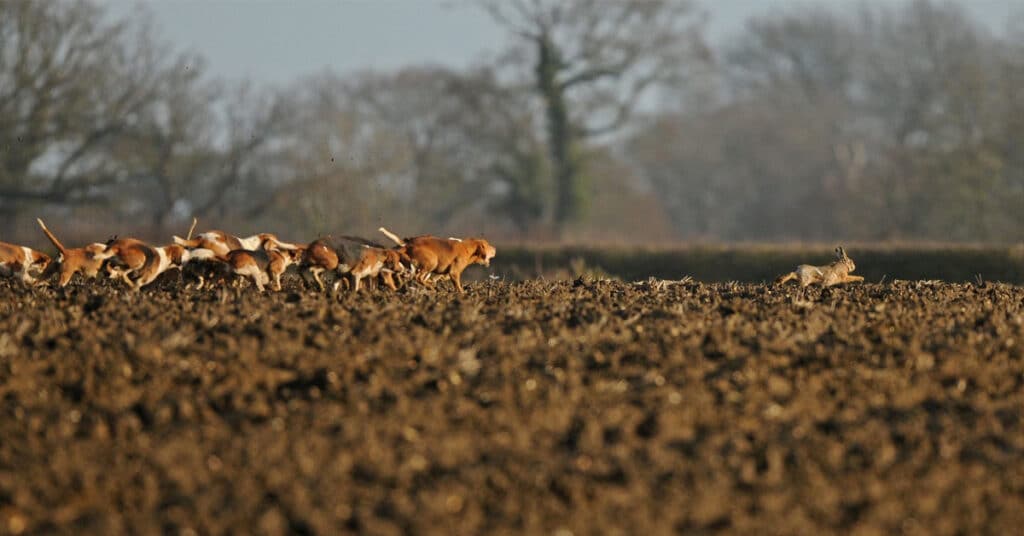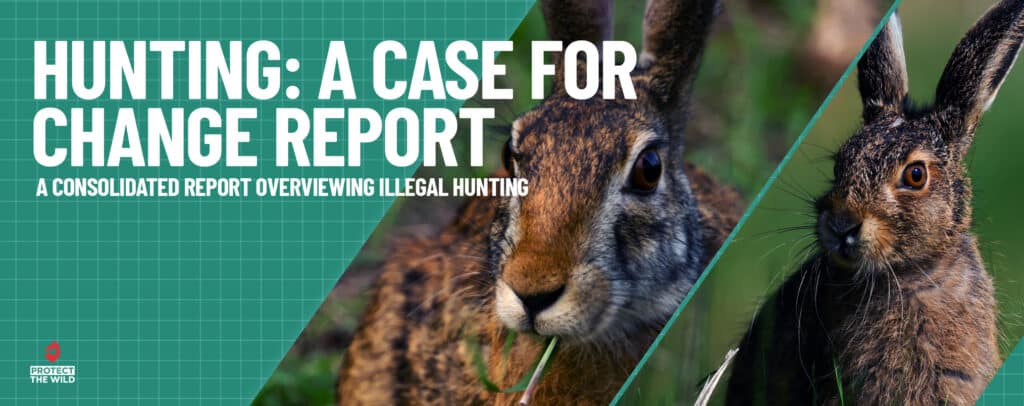Protect the Wild recently published “Hunting: A Case for Change“, a 50-page report that offers a thorough examination of hunting practices during the 2022/23 season. The report focusses predominantly on fox, hare, and deer hunting in England and Wales.
Author Glen Black utilised a combination of online data from anti-hunting groups, public reports, and activist observations to evaluate the prevalence and impact of hunting on wildlife, communities, and individuals.
“Hunting: A Case for Change” underscores persistent violations and the far-reaching implications on wildlife populations, local communities, and the wider general public, which we are now looking at in a series of posts.

Download ‘Hunting: A Case for Change’ as a pdf.
Hare Hunting
Hare hunting is fox hunting’s lesser known but no less cruel sibling. If dozens of humans using dozens of hounds to chase and kill a single fox is a difficult enough pastime to defend, replacing the fox with the more vulnerable-looking hare is even more so.
Although there were nearly 70 active hare hunting packs during the 2022/23 season, they only turned up a handful of times in public reports. In fact, according to data used to create Protect the Wild’s report on the 2022/23 hunting season, there were only 11 hare chases (and no kills) reported in connection with hare hunting packs. Yet the report on the 2022/23 hunting season revealed that there were likely more than 2000 meets held by hunts that chase and kill hares as their primary quarry.
Why is there such a disparity?

First, an explanation
As Protect the Wild has previously explained, when it comes to hunting hares with hounds, there are three different types of packs: harriers, beagles and bassets. Harriers are hunted from horseback and largely resemble the traditional image of a fox hunt. However, while there remain 11 harrier packs left in England and Wales, most of them hunt a combination of foxes and hares or foxes exclusively. Only a small number – such as the Dunston Harriers and Holcombe Hunt – remain as ‘pure’ hare hunts.
Beagles are hunted on foot and are the most numerous of the three. The hunts will conduct the entire meet by walking and running, casting hounds in circles around fields to pick up the scent of hares. There were 57 beagle packs operating in England and Wale during the 2022/23 season. Meanwhile, just seven basset packs were operating during the same period. Bassets are hunted on foot, much like beagles, but are smaller and slower creatures. However, they possess stamina and will exhaust a hare. Supporters say bassets are marked out from beagles by their more ‘interesting’ houndwork.
The breakdown of what packs chased how many hares is as follows:
- Beagles: 7
- Bassets: 3
- Harriers: 1
On the face of it, these figures appear low. By comparison, saboteurs reported the Warwickshire Hunt alone chasing 39 different foxes during the same season.

Vulnerability and Direct Action
There are a couple of major factors in the low incidence rate of beagle and basset packs, both of which are derived from them being hunted on foot.
Firstly, they are able to keep a much lower profile as they don’t require horses. The hunt can transport its pack in a pick-up or transit van and other staff and followers can travel in cars. A collection of 4x4s and normal cars parked up just off the road is much less conspicuous than a large group of horse trailers and horseboxes. Similarly, because they are walking across the countryside and not galloping across it on horses, they are less noticeable when in action. The fact that most hare-hunting foot packs wear green jackets, which blend into the countryside more easily than the red of foxhound packs, reinforces this.
Secondly, because they hunt on foot, if sabs or monitors do turn up, they don’t have the choice to simply run away. Mounted hunts often exploit the speed of horses to get away from activists and continue hunting. Without that advantage, beagle and basset packs are much more vulnerable to the impact of direct action. So vulnerable, in fact, that most will simply end their meets when sabs arrive – if they leave the meet at all.
In all reported instances of beagles and bassets chasing hares, the incidents were seen as activists arrived at the scene or very soon after, with the hunt packing up quickly afterwards. This is seen, for example, at the Severn Vale Beagles meet on 1 October 2022 and the De Burgh and North Essex Bassets meet on 7 January 2023.
The reasons for low harrier pack figures are less easy to pin down. Most likely it is a combination of how few of them hunt hares, trail hunting being a less convincing smokescreen for hunting hares than foxes, and a generally lesser focus on them than foxhound packs by activists.
In the end, the figures are a testament to the power of direct action. Nowhere is the impact of saboteurs and monitors more obvious than in the low incidence rate of hare hunts.
What they do in the shadows
Nonetheless, hare hunts are observed far less than fox hunts, in part due to the previously mentioned inconspicuousness. Therefore, to calculate how many hare hunting meets were held during the season, it was a case of using averages to establish the final figure. Assuming an average of one meet per week for 72 hunts between 1 September 2022 and 31 March 2023, we arrive at a figure of 2160.
Most of these go unobserved by activists or the public. So, while the figures are a story of the impact of direct action, they’re also a story of how many hares might be hunted every year.
The nervousness hare hunts have around saboteurs hints at what they are doing when they go unobserved. It’s highly likely that most if not all simply continue hunting hares with impunity. Harriers, beagles and bassets also traditionally hunted more hares per meet than foxhounds would hunt foxes.
Whilst it is difficult to draw any firm conclusions about the number of hares hunted from available data, it is fair to speculate that the number is very high – although any number above zero is too high for a pastime that the law was supposed to have banned nearly 20 years ago.
SPECIAL ACKNOWLEDGEMENT
“Hunting: A Case for Change” couldn’t have been written without the courageous monitors and saboteurs out in the field standing up to the hunts. Their tireless work throughout the hunting season and their dedication in writing reports on their experiences continues to be absolutely vital. Without direct action the public cannot be shown what really goes on in the British countryside. To thank the brave sabs and monitors who witnessed all of this first hand, please consider supporting your local hunt saboteur or monitor group.

